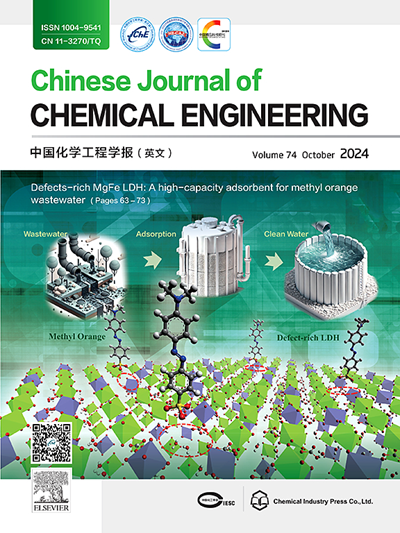通过在 Ni/Al2O3 中掺杂 CeO2 和堆叠催化剂床层提高 CO2 甲烷化效果
IF 3.7
3区 工程技术
Q2 ENGINEERING, CHEMICAL
引用次数: 0
摘要
本研究合成了一系列不同掺杂量 CeO2 的 Ni/CeO2/Al2O3 催化剂,以提高低温 CO2 甲烷化的效果。CeO2 的引入削弱了 Ni 与 Al2O3 之间的相互作用,从而形成了 Ni-CeO2 活性位点。这使得 Ni 和 CeO2 高度分散,提高了催化剂的还原性,增加了活性位点的数量,并增强了 CO2 甲烷化。这项工作进一步研究了 WHSV 和催化剂堆叠结构对增强反应的影响。在 WHSV = 9000 ml-h-1-g-1 条件下,将催化剂按 330 ℃、300 ℃ 和 250 ℃ 的温度梯度堆叠成三段时,二氧化碳转化率显著提高到 95%,非常接近热力学平衡(96%)。本文章由计算机程序翻译,如有差异,请以英文原文为准。

Enhancing CO2 methanation via doping CeO2 to Ni/Al2O3 and stacking catalyst beds
This work synthesized a series of Ni/CeO2/Al2O3 catalysts with varying CeO2 doping amounts to enhance low-temperature CO2 methanation. The introduction of CeO2 weakens the interaction between Ni and Al2O3, leading to the formation of Ni-CeO2 active sites. This results in a high dispersion of Ni and CeO2, improved catalyst reducibility, increased number of active sites, and enhanced the CO2 methanation. This work further investigated the impact of WHSV and catalyst stacking configuration to enhance the reaction. When the catalyst is stacked into three segments with a temperature gradient of 330 °C, 300 °C, and 250 °C under WHSV = 9000 ml·h–1·g−1, the CO2 conversion significantly increases to 95%, which is remarkably close to the thermodynamic equilibrium (96%).
求助全文
通过发布文献求助,成功后即可免费获取论文全文。
去求助
来源期刊

Chinese Journal of Chemical Engineering
工程技术-工程:化工
CiteScore
6.60
自引率
5.30%
发文量
4309
审稿时长
31 days
期刊介绍:
The Chinese Journal of Chemical Engineering (Monthly, started in 1982) is the official journal of the Chemical Industry and Engineering Society of China and published by the Chemical Industry Press Co. Ltd. The aim of the journal is to develop the international exchange of scientific and technical information in the field of chemical engineering. It publishes original research papers that cover the major advancements and achievements in chemical engineering in China as well as some articles from overseas contributors.
The topics of journal include chemical engineering, chemical technology, biochemical engineering, energy and environmental engineering and other relevant fields. Papers are published on the basis of their relevance to theoretical research, practical application or potential uses in the industry as Research Papers, Communications, Reviews and Perspectives. Prominent domestic and overseas chemical experts and scholars have been invited to form an International Advisory Board and the Editorial Committee. It enjoys recognition among Chinese academia and industry as a reliable source of information of what is going on in chemical engineering research, both domestic and abroad.
 求助内容:
求助内容: 应助结果提醒方式:
应助结果提醒方式:


